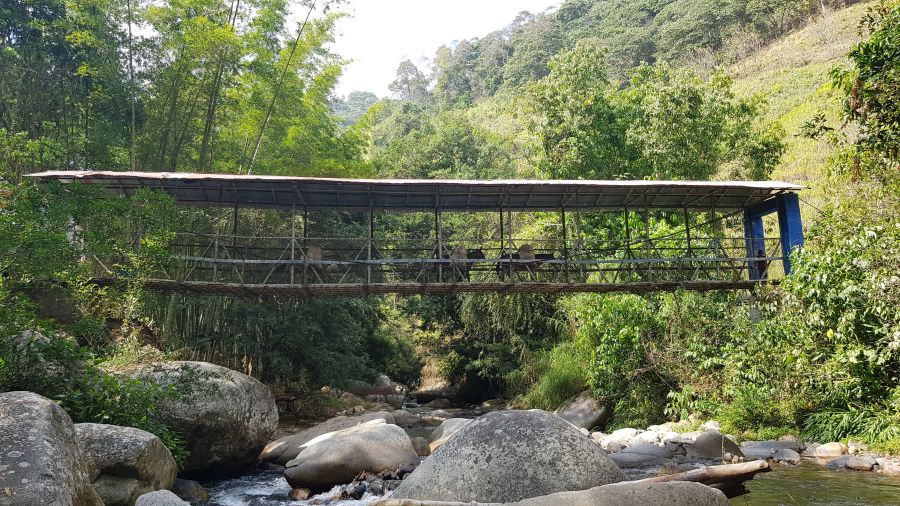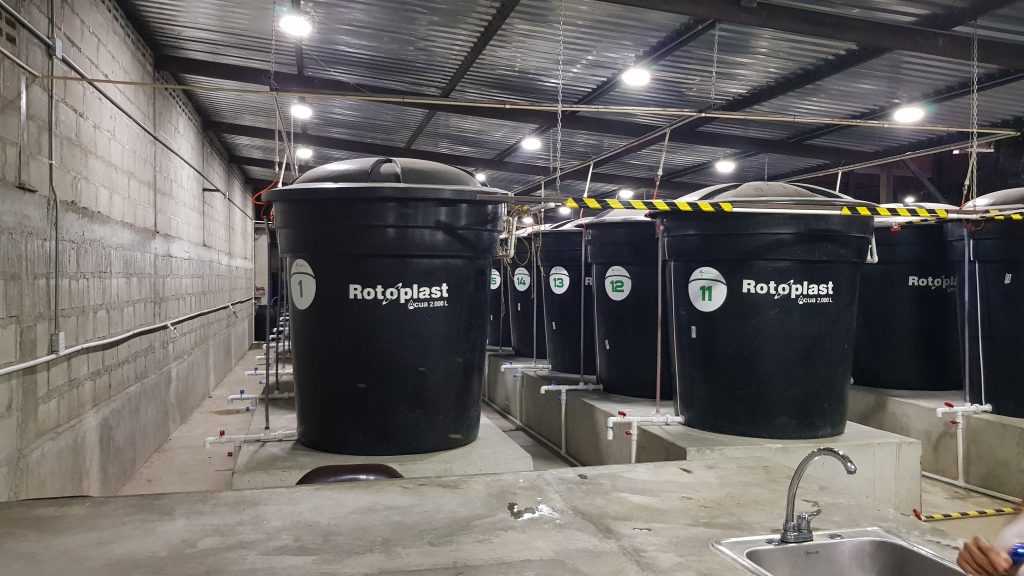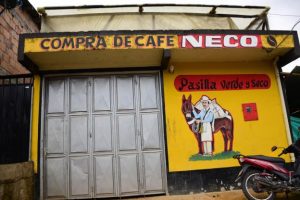In the morning we have breakfast with a view over the green Sierra Nevada. Nevada means snow-covered, but snow is extremely rare here in the Caribbean, even at this altitude. Right after breakfast we take a look at “Finca Buenos Aires”, where we spent the night. The name immediately reminds us of the capital of Argentina, but you could translate the name with “estate (finca) of the good air” – and there is indeed plenty of good air here.




We inspect the washing and drying facilities for the coffee and also see the accommodation for the pickers. They are mostly seasonal workers and usually come from far away, from completely different parts of Colombia, and are only on the fincas during the harvest season.
Once the harvest season is over here, they move on or go back to their own fincas. Due to the different climates of Colombia, there is usually work for them somewhere. However, the workers are the ones who get paid the least – and so I wonder who the Fairtrade system actually takes into account. Fairtrade certification is usually only granted if all workers are paid the minimum wage, but as already described in other articles (click here), this is less than 300 € in Colombia, which is too low for a good life.

While the roasters have the processes explained to them in detail and some of them pose for pictures for their websites, newsletters and Instagram accounts, I fool around with three of the kids. They are the two brothers who live on the finca and their cousin who lives on the neighboring finca. They don’t get that many visitors here in seclusion, so I’m sure it’s especially exciting for them to have so many people as guests. Like many children, they are fascinated by our SLR cameras. They pose, always want us to take pictures of them and are happy when they finally get the cameras in their hands and can take pictures themselves.



We first descend the mountain, visit a neighbor with a finca and admire the small vegetable garden there – it’s great how everything grows so much better and seemingly more effortlessly here due to the warm and humid climate than in our gardens at home in Germany!

Then it’s back on mules and on foot the rest of the way back. The way back seems shorter and less strenuous than the same way yesterday. Maybe because we know the way now.
Or also because we make a short stop in between when we see a man with a tame Tucan. He has found the young animal and raised it by hand, now he feeds him a banana.



When we reach the village, we see women and children coming out of the church and men sitting with a beer in the village square. It is Sunday. Some men are also playing tejo. We have the game explained to us. Tejo has about the same meaning in Colombia as bowling has in Germany. The main components of the game are a target and a projectile with which the goal is to hit the target from some distance. The peculiarity is that the target is small packets filled with black powder and the projectile is a kind of metal puck. The target packets lie on a metal ring, which in turn lies in an inclined box with clay. If you hit one of the targets with the projectile (Tejo, from which the game gets its name), there is a small explosion.



While the cafeteros are observing us with a certain amusement we try our luck – and fail miserably! But it is a lot of fun. Ambition is aroused in some of our group and they try a second round. Finally we all give up and admire the game of the Colombians. Seemingly effortlessly they hurl the 1.5 kg tejo to the target, which is 19.5 m away. And *bang* – hit again!
Well, we will probably not become Tejo champions! So we treat ourselves to a beer in the local pub before we have to say goodbye to our hosts. They had also come to the village to spend their Sunday here. We board the jeeps again and wave goodbye once more. Somehow we are all impressed by the work around the coffee and by the people here, by their cheerfulness and hospitality.
The next stop is another finca, where lunch is already waiting for us. We have soup, then meat, rice, salad and fried platano. Same, same.
Meanwhile, we are already squinting at the two parrots of the families.


Everyone is a bit exhausted from the days before, only some still manage to politely address the hosts with questions.
After lunch, we are shown the newly tiled bathrooms and the renovated kitchen as a special feature. The money for this came from the cooperative. And also the equipment for washing and peeling the coffee was installed with the support of Red Ecolsierra.
That is the idea of the cooperative – to improve the lives of the people here. And at the same time, to help them produce better quality for the buyer.
This requires stable partnerships with importers from Europe. Reliable buyers who are prepared to work together for years and pay part of the price up front – like the Café Libertad collective.
These partnerships with pre-agreed prices also bear fruit when prices on the world market rise in unusually bad coffee years with high crop failures. Because then it is otherwise the time of the “coyotes”. These are flying traders who travel around the country and knock on coffee farmers’ doors to buy coffee for the big players such as Nestlé. They become particularly active when suddenly there is no longer enough cheap coffee for their production on the world market.
In such years it can even happen that these middlemen pay more than the Fairtrade buyers. But because of the reliability and community, it is still worthwhile for the members of the cooperative to sell their share to the cooperative even in these years. Because even in other , than the bad harvest years, there are of course other traders in the village, than the cooperative. Because there are of course also farmers who are not organized in the cooperative.
But the associations in cooperatives lead to the fact that the farmers can achieve a higher price with their products. Like mentioned in other articles before on the one hand, this is due to a better negotiating position and market power due to their size, but on the other hand, it is also due to more knowledge and better quality.
In addition, specialty coffee is sometimes fermented to bring out or accentuate certain flavors. At Red Ecolsierra, this is done in the so-called process unit.
Here, there are large vats that look more like catch basins for rainwater. A blackboard with the “recipes” hangs on the wall. Here, the cooperative experiments with aerobic and anaerobic fermentations (i.e., with air exposure and without). Processes of this kind can hardly be implemented by an individual farmer. Another advantage of the cooperative.
It’s not just the technology and knowledge that is needed for this – the sheer space/straight land is often a problem in the mountainous regions. Most of the time, of course, the fincas are located on the slopes where the coffee grows particularly well. There, flat land is scarce. And so it also happens that the coffee delivered to the cooperative is not yet dry enough for storage. In this case, the coffee is sometimes dried in the central warehouse, to which the process unit is connected.


We climb up to a flat roof with a view over the endless monocultures of bananas. And stand under a wonderful mango tree that occasionally drops its ripe fruit with a pop or a splat (depending on the ripeness of the fruit).
With the banana plantations behind us, we see the coffee warehouse. Here the coffee is also tested for its quality before it is sold and transported further.


We wander a bit more through the labyrinth of overman-high stacks of coffee sacks. And we watch the workers of the cooperative stacking them up. It’s hot, it’s dusty, and each coffee sack weighs a whopping 69 kilograms – certainly more than the body weight of some of the workers. It’s a back-breaking job.
It is the last stop with the Red Ecolsierra group and so we say a hearty goodbye before the pickup trucks take us back to the city. Arriving in Santa Marta, we are all happy for a shower and air-conditioned rooms. Unlike the refreshingly cool heights of the Sierra Nevada in the evening, Santa Marta has a Caribbean climate. We enjoy this on the church square with a delicious meal with lots of coconut, in tropical heat under palm trees.




